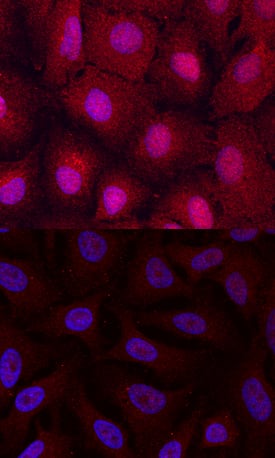EGLN3/PHD3 Products
Egl nine homolog 3 (EGLN3), also known as PHD3, is a widely expressed 27 kDa enzyme that hydroxylates proline residues on target proteins including HIF-1 alpha. HIF-1 is an alpha/beta heterodimeric transcriptional activator that upregulates genes involved in mitigating the effects of hypoxia. Normally, and in the presence of abundant oxygen, the HIF-1 alpha-chain is hydroxylated by PHD family members, which results in its ubiquitylation and degradation. Under low oxygen tension, EGLN3 activity is decreased, the HIF-1 alpha subunit is retained, and HIF-1 activates genes. EGLN3 also hydroxylates and promotes the degradation of the beta-2-adrenergic receptor, promotes myogenic differentiation, promotes apoptosis via caspase activation, and blocks tumor angiogenesis. EGLN3 forms homomultimers and heteromultimers with other EGLN proteins, and this is enhanced during hypoxia. EGLN3 contains one iron 2-oxoglutarate (Fe2OG) dioxygenase domain (aa 278-376), an iron-binding site (Asp137 and His196), and a 2-oxoglutarate-binding site (Arg205).
84 results for "EGLN3/PHD3" in Products
84 results for "EGLN3/PHD3" in Products
EGLN3/PHD3 Products
Egl nine homolog 3 (EGLN3), also known as PHD3, is a widely expressed 27 kDa enzyme that hydroxylates proline residues on target proteins including HIF-1 alpha. HIF-1 is an alpha/beta heterodimeric transcriptional activator that upregulates genes involved in mitigating the effects of hypoxia. Normally, and in the presence of abundant oxygen, the HIF-1 alpha-chain is hydroxylated by PHD family members, which results in its ubiquitylation and degradation. Under low oxygen tension, EGLN3 activity is decreased, the HIF-1 alpha subunit is retained, and HIF-1 activates genes. EGLN3 also hydroxylates and promotes the degradation of the beta-2-adrenergic receptor, promotes myogenic differentiation, promotes apoptosis via caspase activation, and blocks tumor angiogenesis. EGLN3 forms homomultimers and heteromultimers with other EGLN proteins, and this is enhanced during hypoxia. EGLN3 contains one iron 2-oxoglutarate (Fe2OG) dioxygenase domain (aa 278-376), an iron-binding site (Asp137 and His196), and a 2-oxoglutarate-binding site (Arg205).
| Reactivity: | Human, Mouse, Rat |
| Details: | Rabbit IgG Polyclonal |
| Applications: | IHC, WB, ICC/IF, IP, ChIP, +2 More |
| Reactivity: | Human, Mouse, Rat, Primate |
| Details: | Rabbit IgG Polyclonal |
| Applications: | IHC, WB, ICC/IF, IP, Simple Western, +1 More |
| Reactivity: | Human, Rat, Ovine |
| Details: | Mouse IgG1 Monoclonal Clone #EG188e/d5 |
| Applications: | IHC, WB, Simple Western |
| Reactivity: | Human |
| Details: | Mouse IgG2b Monoclonal Clone #700210 |
| Applications: | ICC |
| Applications: | WB |
| Applications: | AC |
| Applications: | AC |
| Applications: | PAGE |
Recombinant Monoclonal Antibody
| Reactivity: | Human, Mouse |
| Details: | Rabbit IgG Monoclonal Clone #JE60-82 |
| Applications: | WB |
| Reactivity: | Human |
| Details: | Rabbit IgG Polyclonal |
| Applications: | ICC/IF |
| Applications: | AC |
| Reactivity: | Human, Rat |
| Details: | Mouse IgG1 Monoclonal Clone #EG188e/d5 |
| Applications: | IHC, WB, Simple Western |
| Reactivity: | Human, Mouse, Rat, Primate |
| Details: | Rabbit IgG Polyclonal |
| Applications: | IHC, WB, ICC/IF, IP, Simple Western, +1 More |
| Reactivity: | Human, Mouse, Rat |
| Details: | Rabbit IgG Polyclonal |
| Applications: | IHC, WB, ICC/IF, IP, ChIP, +2 More |
| Reactivity: | Human, Mouse, Rat, Primate |
| Details: | Rabbit IgG Polyclonal |
| Applications: | IHC, WB, ICC/IF, IP, Simple Western, +1 More |
| Reactivity: | Human, Rat |
| Details: | Mouse IgG1 Monoclonal Clone #EG188e/d5 |
| Applications: | IHC, WB, Simple Western |
| Reactivity: | Human, Mouse, Rat |
| Details: | Rabbit IgG Polyclonal |
| Applications: | IHC, WB, ICC/IF, IP, ChIP, +2 More |
| Reactivity: | Human, Rat |
| Details: | Mouse IgG1 Monoclonal Clone #EG188e/d5 |
| Applications: | IHC, WB, Simple Western |
| Reactivity: | Human, Mouse, Rat, Primate |
| Details: | Rabbit IgG Polyclonal |
| Applications: | IHC, WB, ICC/IF, IP, Simple Western, +1 More |
| Reactivity: | Human, Rat |
| Details: | Mouse IgG1 Monoclonal Clone #EG188e/d5 |
| Applications: | IHC, WB, Simple Western |
| Reactivity: | Human, Rat |
| Details: | Mouse IgG1 Monoclonal Clone #EG188e/d5 |
| Applications: | IHC, WB, Simple Western |
| Reactivity: | Human, Mouse, Rat |
| Details: | Rabbit IgG Polyclonal |
| Applications: | IHC, WB, ICC/IF, IP, ChIP, +2 More |
| Reactivity: | Human, Mouse, Rat, Primate |
| Details: | Rabbit IgG Polyclonal |
| Applications: | IHC, WB, ICC/IF, IP, Simple Western, +1 More |
| Reactivity: | Human, Rat |
| Details: | Mouse IgG1 Monoclonal Clone #EG188e/d5 |
| Applications: | IHC, WB, Simple Western |
| Reactivity: | Human, Mouse, Rat |
| Details: | Rabbit IgG Polyclonal |
| Applications: | IHC, WB, ICC/IF, IP, ChIP, +2 More |

![Western Blot: EGLN3/PHD3 Antibody - BSA Free [NB100-139] Western Blot: EGLN3/PHD3 Antibody - BSA Free [NB100-139]](https://resources.bio-techne.com/images/products/EGLN3-PHD3-Antibody-Knockdown-Validated-NB100-139-img0017.jpg)
![Western Blot: EGLN3/PHD3 AntibodyBSA Free [NB100-303] Western Blot: EGLN3/PHD3 AntibodyBSA Free [NB100-303]](https://resources.bio-techne.com/images/products/EGLN3-PHD3-Antibody-Western-Blot-NB100-303-img0004.jpg)
![Western Blot: EGLN3/PHD3 Antibody (EG188e/d5)BSA Free [NBP1-30440] Western Blot: EGLN3/PHD3 Antibody (EG188e/d5)BSA Free [NBP1-30440]](https://resources.bio-techne.com/images/products/EGLN3-PHD3-Antibody-EG188e-d5-Western-Blot-NBP1-30440-img0007.jpg)


![Western Blot: EGLN3/PHD3 Overexpression Lysate [NBL1-10156] Western Blot: EGLN3/PHD3 Overexpression Lysate [NBL1-10156]](https://resources.bio-techne.com/images/products/PHD3-HIF-Prolyl-Hydroxylase-3-Overexpression-Lysate-Adult-Normal-Western-Blot-NBL1-10156-img0003.jpg)
![SDS-PAGE: Recombinant Human EGLN3/PHD3 His Protein [NBP2-53035] SDS-PAGE: Recombinant Human EGLN3/PHD3 His Protein [NBP2-53035]](https://resources.bio-techne.com/images/products/Recombinant)
![Western Blot: EGLN3/PHD3 Antibody (JE60-82) [NBP3-32745] EGLN3/PHD3 Antibody (JE60-82)](https://resources.bio-techne.com/images/products/nbp3-32745_rabbit-egln3-phd3-mab-je60-82-27820241631688.jpg)
![Immunocytochemistry/ Immunofluorescence: EGLN3/PHD3 Antibody [NBP2-57377] Immunocytochemistry/ Immunofluorescence: EGLN3/PHD3 Antibody [NBP2-57377]](https://resources.bio-techne.com/images/products/EGLN3-PHD3-Antibody-Immunocytochemistry-Immunofluorescence-NBP2-57377-img0001.jpg)
